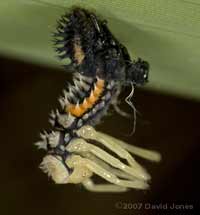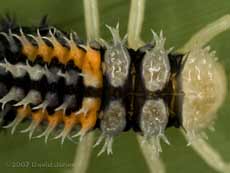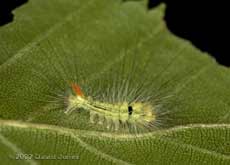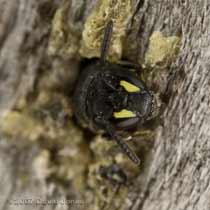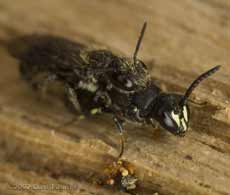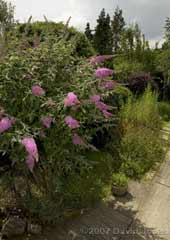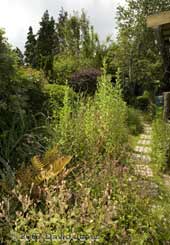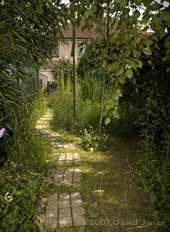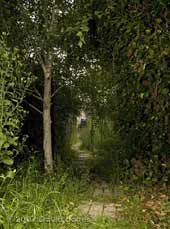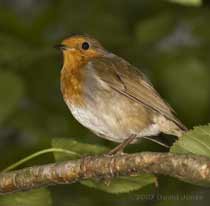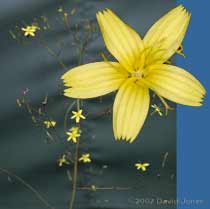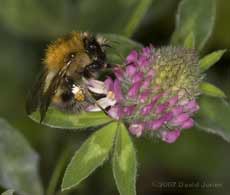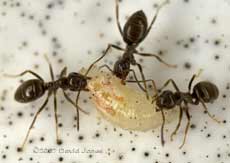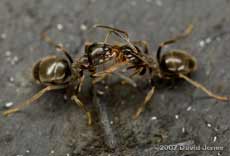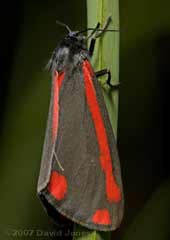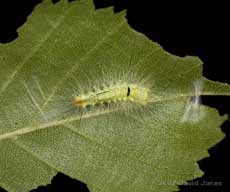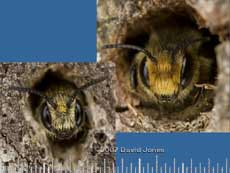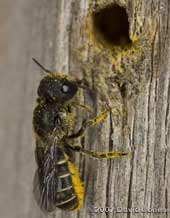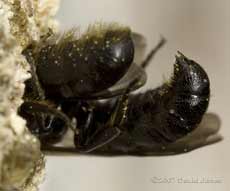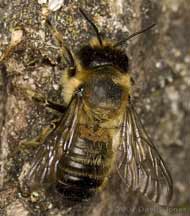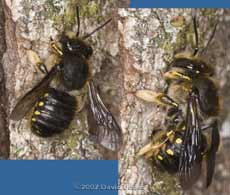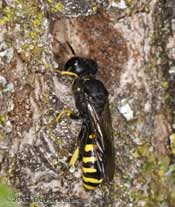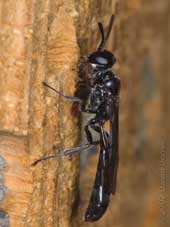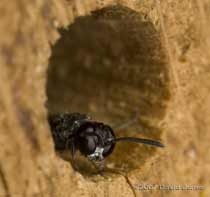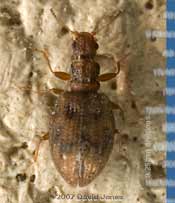Go to the last entry on this page .....Go to previous entry22 June - I'm afraid the last few days have been another one of those weary periods for me. Since the last entry, the weather has been mixed. It has been cooler, with less sunshine, although while some parts of the country have had lots of rain (and floods) we have had only a few showers. Having said that, a couple of days ago we had a real cracker of a thunder storm which gave us a brief spell of heavy rain and also caused the computer to reboot, giving me a moment of panic over its well-being. Hopefully, the big pictures will be added before the end of the day (if the force stays with me!)
I have caught two more adults, discovered another pupa on the side of a water butt, and then yesterday I spotted this larva undergoing a moult on a bamboo leaf (the plants by the side of our parking area).
This close-up shows that the spines on the back of the larva are tipped with needle-like hairs (you need to look at the large image to see them!). I wonder of these have a protective function, as do the hairs on many caterpillars.
Talking of caterpillars, the little one that I photographed on 9/10 June is still very hairy but has now grown to about 1cm in length and has developed a striking tuft of red hairs at its rear end. This picture was taken yesterday. This morning it looks unchanged, except that the front end of the body is arched up slightly, at the point where you can see the black marking, and it has moved to a different leaf.
Not a 'usual resident', I think it's one of the 'Yellow-faced mining bees'. I have not been able to match the face for ID purposes. Back on 4 July 2005 I saw a male Hylaeus communis here. That is a common species of the same group (although not seen here since!) but its face was almost all yellow.
While the first bee continued to look out from the hole, on the top of another part of the bee hotel I spotted this pair mating (or is it a case of mistaken identity between two different species?). They stayed together for over ten minutes, although their position made it difficult to get close to them. I did 'capture' them in the hope of getting some some close-up shots, but they kept moving, I couldn't keep up(!), and I released them again after just a couple of minutes.
Again, I'm stuck for an ID. The BWARS site has an identification key on test for the males of what it refers to as 'White-faced Bees' (but which includes the Yellow-faced Bees). That suggests that as the male in ths picture has no light markings on its face this pair could be Hylaeus cornutus, but so far I haven't been able to find any pictures or other information that would help to confirm that ID. Yesterday we visited a garden centre and had lunch there. Throughout our meal we were entertained by a Moorhen and her two chicks that were scouring the outside eating area for crumbs! We expect to see the likes of Robins, Blackbirds, and Sparrows, but this is the first time I've seen Moorhens doing this. They scurried for the cover of the bushes every time a human came by. I'd never realised quite how green the legs are of the adult Moorhen, and picking up crumbs of a solid surface seemed quite an awkward manoeuvre for them. They had to lean forward quite a lot, and then turn their heads sideways and use the side of the beak rather than peck at the food. Back in the garden, it seems to be very quiet on the bird front. The House Sparrows and Starlings continue to take food away for their nestlings, the Blue and Great Tits visit the feeders frequently, and the Robins (adult and a juvenile) come for the mealworms. On the other hand, while the Blackbird male continues to sing, we rarely see any Blackbird down in the garden, the Goldfinches appear only infrequently, and I haven't seen a Dunnock for weeks now. Over the last week I've seen just a single Chaffinch (female) in the garden, and I hear and then spotted a Greenfinch in the conifers (but not in the garden). And the Squirrel was here again, just briefly, yesterday morning. The Buddleia has come into flower over these last few days, but we are still waiting for the butterflies to get going (just a glimpse of one passing by during the past week).
24 June - The day has been grey and wet, giving me the chance to catch up with the big pictures in the previous entry, as well as adding some pictures taken yesterday.
Yesterday was mainly bright, good enough for us to have lunch outside before heavy showers arrived in the late afternoon. I took advantage of the sunshine to take a few garden views, starting with this one to record the Buddleia.
Heading down the garden, this is the view as you head for the big pond. Yes, the pond is there, hidden behind the tall stems of the Great Willowherb (which hasn't started flowering yet).
When you walk down the path as far as the Birch and turn around, this is the view you get looking back towards the house. You can see the Buddleia in the background, just in front of the water butts that store rainwater collected from our veranda roof (with the overflow supplying the small pond).
Finally, the same view from the West Wing. The last few months during which I have been restricted in how much I could do in the garden (a situation that will continue for another month or so) have given me the opportunity to sit back and watch what happens when areas of the garden are left alone. Gradually, I'm doing some judicious pruning and removing of ground Ivy where it threatens to take over, but otherwise it's nice to be able to be in parts of the garden where I can imaging being in woodland, and almost completely forget that we are surrounded by other houses (until the lawn mowers and strimmers start up!).
Nearly every time I walk down to this part of the garden I'm greeted by one of our Robins, perching on a branch of the Birch. It seems ages since I last took a bird photograph in the garden.
While I'm starting to tidy bits up around the garden, I also continue to look out for what I can add. Our shared driveway is paved with concrete and last year I noticed that a 'different' plant appeared at the junction of my neighbours' house wall and the drive. This year several more examples of it appeared and a couple of days ago I decided to rescue a couple of the plants (just in time before the rest were 'weeded'!
The plant is a Wall Lettuce (Mycelis muralis), with even more delicate flowers than the Nippleworts we already have in the garden. In the wild the plant grows in woods on calcareous soils, as well as calcareous rocks and walls (explains why it liked its position in the driveway). I planted them right next to the concrete of the caravan parking area in the hope that it provides the required conditions, and they seem to be recovering well from the transplant.
In the same area, I've been very pleased with the way the Red Clover has started to spread since its introduction in April. Its flowers are getting regular visits from Bumblebees such as this Carder Bee. I'm still uncertain of the species of the Carder Bees that are nesting here in the garden.
While we had lunch yesterday I spotted this trio of ants struggling to move something along the side of my kayak. It turned out to be a a very plump hoverfly larva, obviously destined to become food for the ants' youngsters. During the morning I saw (but did not photograph) a solitary winged queen ant climbing up one of the caravan shelter supports. There was no sign of any other winged ants during the rest of the day.
29 June - After a very wet start, I think we have had more sunshine today than the last four days put together, and after an unseasonable cold spell the temperature reached 21C this afternoon - it's almost summer again before things are forecast to go downhill again on the weekend. For me, the battle to stay awake continues, with just a small number of photographs taken since the last entry.
The first picture is of a pair of ants that met up and had a 'conversation' on a water butt. They seemed to interlock their jaws as their antennae waved about. They stayed together for about half a minute before going their own way.
Yesterday, there were Cinnabar moths in the garden which I suspect had just emerged from the brood that were produced here last year. I didn't see any today.
Each day, I have been checking on the caterpillar on the Birch tree, and yesterday I took this picture to show it with some silk structures in front and behind it. Sadly, when I looked again this morning there was no sign of the caterpillar. I can only guess that it may have been dislodged by the rain this morning.
During the cold spell the bee hotels have been rather quiet, but every time the sun comes out, so do the bees. Much of the time when it's cloudy you can see them peering out from the holes. I put this pair of images, shown at the same scale (the small hole is about 3mm across) to give an idea of the variation of bee sizes present.
This is one of our H. truncorum bees, a female with the pollen combs under her abdomen turned yellow.
In this picture it seems that a female is keen to get into one of the small holes as a male attempts to mate with her. They spent several minutes in this position before reversing out and separating.
This is one of the larger bees that visits the 7mm holes. Look carefully at its abdomen and you will see that it is suffering from a serious infestation of orange-coloured mites(?). Looking through my insect guides, the best match I can find is Stelis punctulatissima (or similar?). If this is the case then it is a cuckoo species, laying its eggs in the nests of Osmia and Anthidium species of solitary bees. I had hoped to get some closer shots to get more detail, but these bees are very sensitive to the movement of the camera near them.
In the absence of the Ragwort plants, we have tried to provide alternative pollen sources. We bought a selection of plants. Two that have proved very popular with the smaller bees are a Daisy (Shasta Snowlady) and an annual called Cosmos Sonata (a daily like flower with large white petals). As an experiment we also bought two more plants that produce yellow pollen (Fleabane - Erigeron aurantiacus) and Osteospermum Stardust) but which attract few of our bees. Another plant, with bright blue flowers and with blue pollen has been as far as I can tell, completely ignored, despite being nearer the main bee hotel than the other plants.
It looks as though it's a Wool Carder Bee (Anthidium manicatum). The male is larger than the female and is territorial, and the female uses fibres from the leaves of hairy plants to line her nest.
Another elusive visitor over the last week or so has been this solitary wasp, and I managed just this one shot of it today before it disappeared again. My first attempts at identification have failed on this one.
Another solitary wasp that is more familiar here is this slender, completely black species. This is probably either Trypoxylon figulus or T. attenuatum. I'm inclined to think it's the latter because it appears to have a narrow first abdominal segment, which is a characteristic of T. attenuatum.
This image of the same individual looking out of a 7mm (diameter) hole shows the notched inner margins of the eyes (above the antennae), a characteristic of the Trypoxylon genus.
Finally, during a sunny spell this afternoon, I spent a few minutes 'chasing' this tiny beetle (which I can't identify) as it dashed about on the rain cover on a garden table. It's amazing to think that a beetle this small can share all the beetle characteristics that you see in something as large as a Stag Beetle, and this individual demonstrated that flying is no problem!
There were butterflies about today. Over a ten minute period I saw a Red Admiral, a Peacock, a Holly Blue and a Large White. What was annoying was that they all flew past the Buddleia flowers without stopping! Click on images to see larger versions |
|
